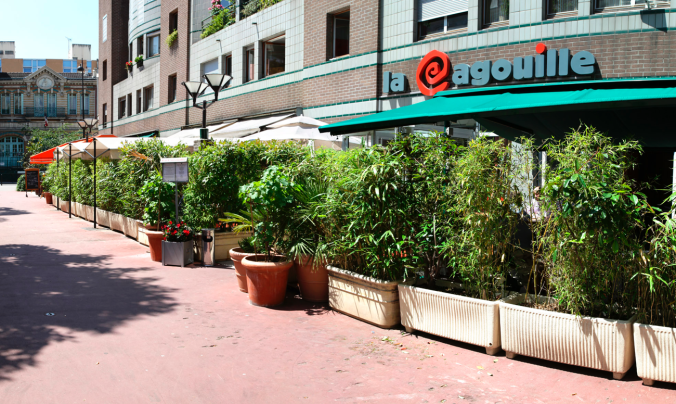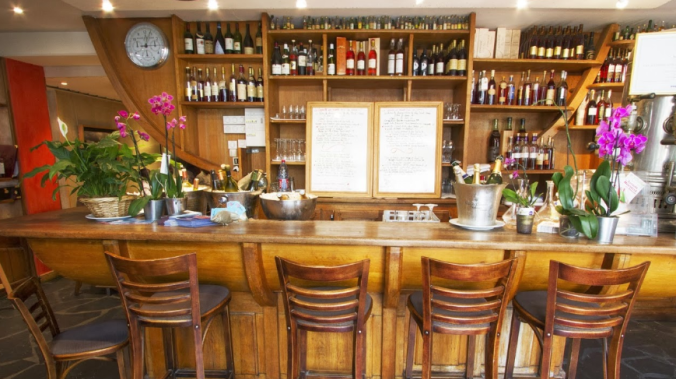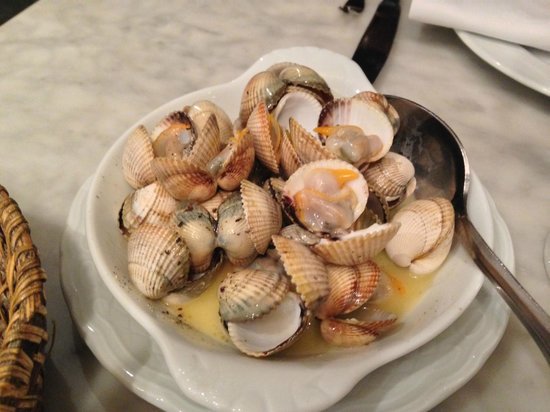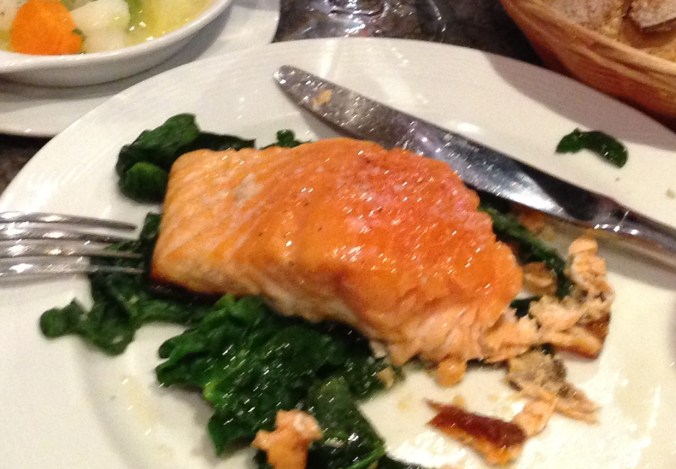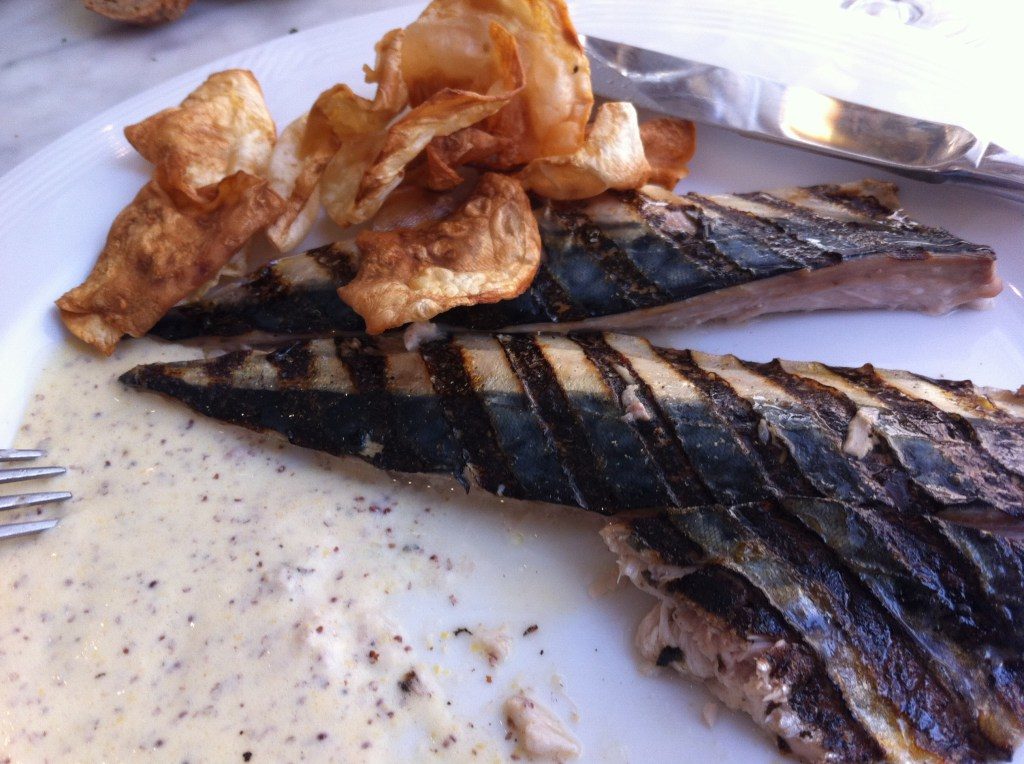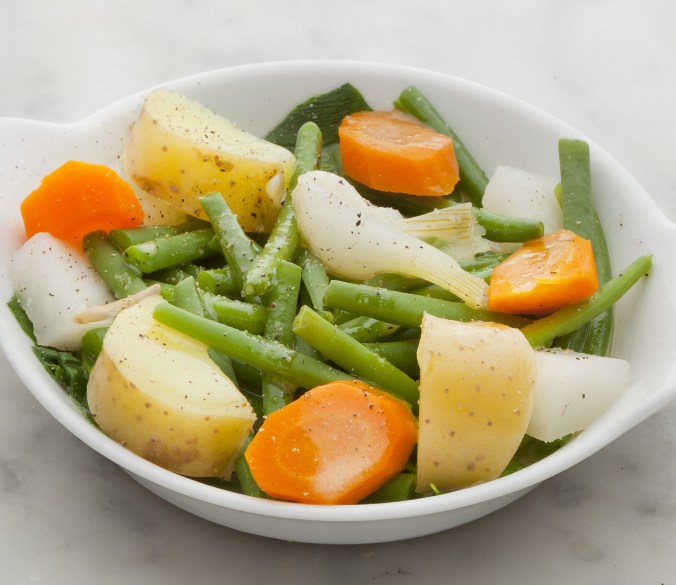There is a restaurant in Paris that I like very much.
Truth be told, there are a dozen or more restaurants in Paris I like very much and if you ask me, or even if you don’t, I’ll make a list of them for you. But I’m here to discuss only one of these restaurants. A couple of years ago a very pleasant thing happened there, and since I gripe generously about bad things, when nice things happen it’s fair that I mention them.
When you hand over enough money for a meal in a restaurant, it is reasonable to expect that nice things will happen. La Cagouille isn’t particularly expensive; you can eat for around $40 if you order the prix fixe. (You won’t get any wine for that price, which would be sad, but you will survive.)
On the Zagat guide’s zero-to-30 scale, La Cagouille (pronounced ca-gwee, pretty much) scores around 36 for food, yet I’ve never met an American who’s heard of it. Very few Parisians I’ve met, even the sophisticated eaters, know of it.
Nestled behind a bank of wispy eight-foot-high trees — I don’t know the French names of trees except oaks, pines and cedars, and the trees in front of La Cagouille are not oaks, pines or cedars — on the ground floor of a ’70s-era Montparnasse apartment building, the restaurant could reasonably be mistaken for a day care center.
When you enter you’re in the bar. At first all you see is wood, and the vibe is clubby. But then you notice the nautical details. The wall of shelves behind the bar, stocked almost entirely with bottles of Cognac, is a cross section of a ship’s hull. The bar itself is curved like a skiff’s bottom. If you want to make sure you’re on time for your reservation, you may glance at the ship’s clock on the wall.
With a turn to the left you’re in the dining room. Its crisp, contemporary décor invites and comforts. A floor-to-ceiling glass enclosure filled with the shells of assorted mollusks dominates a wall. This and the rest of the nautical features make sense because La Cagouille is a seafood restaurant.
Cagouille is what people in the Charente region of France affectionately call snails, so that makes sense, too. If you, like the Charentais people, wish to celebrate la cagouille, you may do so at a festival for that purpose during the first weekend of September in Saint-Sauveur d’Aunis.
Do not go to La Cagouille thinking, as people who do not care for seafood might, “Oh, these places always have something besides fish. If it’s where you want to go, honey, I’ll be fine.”
You won’t be fine. There is nothing on the menu besides seafood. Little fish, big fish, cockles, clams, oysters, shrimp, fish from rivers and fish from the sea.
(It has not slipped my mind, by the way, that I am here to tell about something pleasant that happened at La Cagouille. In due time. I’m setting the scene, if you don’t mind, or even if you do. You’re free to leave.)
They don’t seem to speak English at La Cagouille, which makes it all the more interesting that their website has a quite-good English version.
From the French version, here is the menu.
Before your meal arrives a bowl of cockles will appear on the table. From each little shell you will extract a nugget of clammy wonderfulness the size of your thumbnail. You will dip it in the butter bath in which it has warmed, and then, as you eat it, marvel at its tender, gentle reminiscence of the Atlantic. This course is free.
Among the specialties is Salmon à l’unilateral, a fat fillet cooked only on the skin side so that in the space of a few centimeters the flesh ranges from bright coral to the pale hue of an underripe cantaloupe. Mussels brûle doigts will indeed burn your fingers, as the name suggests; they were cooked in the same very hot cast-iron skillet in which they are delivered to your table.
My favorite dish at La Cagouille is grilled mackerel with mustard sauce. Of the seven or eight times I’ve eaten there, this, best I can remember, has been my main course four or five of them. Like everything in the restaurant, it is prepared simply and as described.
La Cagouille does not go in for fussy side dishes. They are well executed but one wonders if they exist as a matter of “it would just be weird if we didn’t” more than “people expect them.”
On January 1, 2014, Calvin and I happened to be in Paris. We had arrived there a couple of days earlier on an overnight train from Berlin, Germany. That trip was the first time I had ever occupied a sleeper compartment on a train, and I envisioned beforehand something along the lines of Murder on the Orient Express, From Russian With Love and Silver Streak.
The train trip turned out, however, to be something quite different.
(I have still not forgotten about the business of the pleasant thing that happened at La Cagouille. Lighten up. I’ll get there.)
Calvin and I paid $500 for the use of a little sleeper compartment for 12 hours.
It was a train with no dining car attached to it.
It was a good thing we had bought bread, smoked meat and wine in one of Berlin’s outdoor holiday markets. There was not even a place to buy a bottle of water on that train, much less wine. Not that water was what we wanted to drink.
The train mattresses were remarkably comfortable. There was not, however, much to do except look out of the window, which I did. I lay on my stomach for most of the trip, looking through the window from the lower berth at a series of blurs of white lights in the dark stations of towns I’d never heard of and would likely never know. Northern Germany, it turned out, is not much to look at in the middle of the night in December when viewed from the window of a railroad car.
We reached Paris around 9 a.m. and stepped down onto the platform at Gare de l’Est. The station — one of seven in Paris — handles rail traffic to and from points east (“est” in French means “east” in English), including the Champagne, Lorraine and Alsace regions of France, and Germany and Russia. The Orient Express originated at Gare de l’Est before it turned into something tacky.
Calvin and I had a difficult time conjuring up the days of the Orient Express when we disembarked from our train and looked behind us.
At the front of a half-dozen tracks in Gare de l’Est were TGV locomotives, which are sleek, pointy-nosed, space-age-y things that make you believe the trains they pull can slither across the countryside at 200 miles per hour, which they do.
When we turned back to look at our own locomotive, that which had pulled us overnight from Berlin, we beheld not a 21st century marvel of speed but a 1986 Ford Fairmont. A dirty, red Ford Fairmont.
Good Lord, was I embarrassed! Did all the French people in the station judge me for my patronage of that ugly train? Did they think I had ridden it to December 2013 from August 1957?
(The French word for train, by the way, is train.)
We had learned before arriving in Paris that Mercedes, a friend from the Los Angeles art world, would be there at the same time, and we agreed to meet for lunch on New Year’s Day.
Mercedes was in Paris with her gentleman, Daniel. I’m highly embarrassed here not to know whether they were then married, partnered or otherwise attached but he was a very pleasant fellow. Daniel lived in Switzerland and came to lunch with his daughter Sophie. Mercedes, of course, was also there, since it was she whom we knew from Los Angeles and with whom we had made our luncheon arrangements, and it would have been mucho awkward if she hadn’t been there, considering that her gentleman, Daniel, and Daniel’s daughter Sophie, were there.
Calvin and I already had a reservation at La Cagouille before we connected with Mercedes. She agreed to bring herself, Daniel and Sophie there to usher in the new year with us.
We all ordered food. La Cagouille is a restaurant, and it would be odd indeed if five people sat down at a table in a restaurant and didn’t order food. And as organizer of the meal, it was also, as they say, “on me” to order wine.
I admire the white wines of Burgundy very much so I chose a Chablis Premier Cru that wasn’t priced too, too extravagantly.
Daniel ordered the next bottle. When the waiter brought a Puligny-Montrachet I twitched a little.
Puligny-Montrachet, also a white Burgundy, is one of my favorite things to drink, so I was eager to have some. It is also considerably more expensive than the Chablis, thus the twitching. My quick mental calculations made me uneasy about the imminent breaking of the budget.
We continued with the meal and had a swell time. Both Calvin and I had ordered that salmon I mentioned earlier.
I don’t remember much else about the meal except that everyone had a good time and that at some point Daniel left the table.
It’s not particularly unusual for a man to get up from a restaurant table so I didn’t dwell on it. I didn’t think to myself, “Where in the world did Daniel go? Why did he leave us on New Year’s Day of all times?”
I believe that at a certain point in a man’s life he ceases wondering where other men go when they get up from the table during meals in restaurants.
Daniel may indeed have gone to the restroom but I don’t know for sure. What I do know is that when I later asked for the check, Daniel said it was handled.
My enjoyment of the Puligny-Montrachet increased retroactively.
Expressions of gratitude were lobbed over the wine glasses. Daniel’s generosity, and his elegant manner of extending it, made a lovely New Year’s Day even lovelier.
That’s the pleasant thing that happened at La Cagouille.
